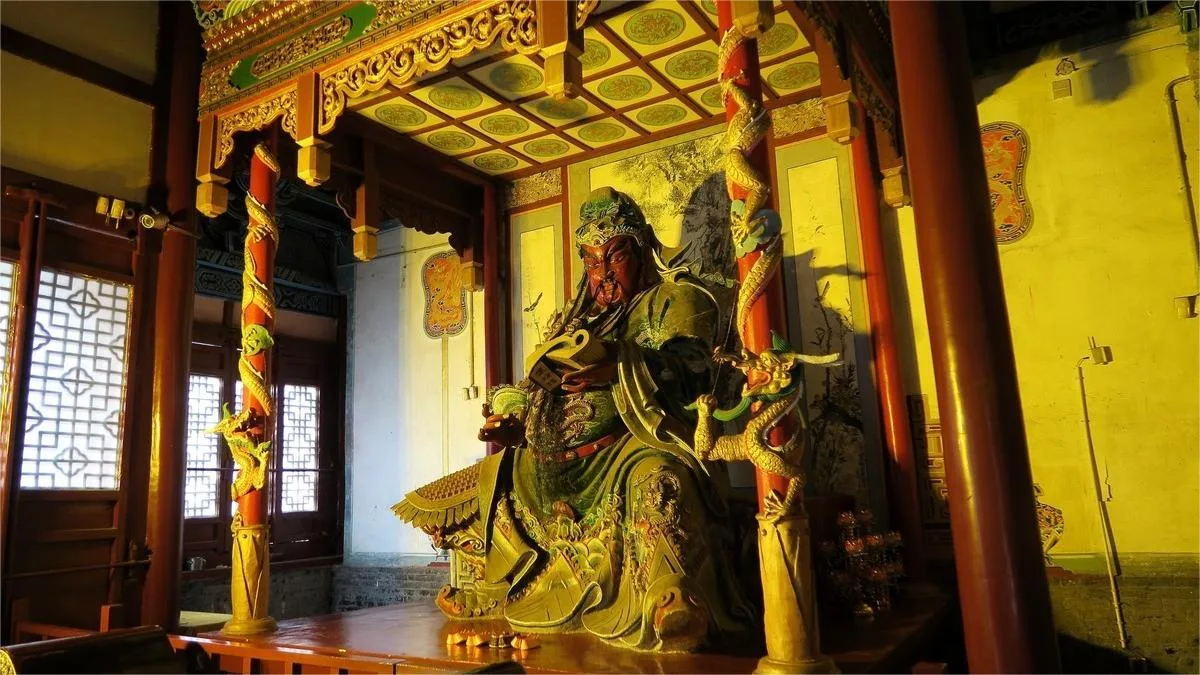Guanlin Temple (关林庙) in Luoyang is the sacred ground where the head of the Shu general Guan Yu was buried during the Three Kingdoms period. It is a shrine and tomb, one of the three major Guan Yu temples both domestically and internationally, uniquely combining a tomb, temple, and forest in ancient Chinese classical architecture. According to ancient feudal rites, imperial tombs are called “ling,” tombs of kings, dukes, and generals are called “zhong,” and only the tomb of a sage can be called “lin.” Over the past two millennia, Guan Yu’s status has ascended from a noble to a martial saint, paralleling only Confucius’s Kong Lin in Qufu, Shandong.
Construction of Guanlin began during the Ming Wanli era and expanded during the Qing Qianlong era. Built in the palace style, the layout is rigorous and majestic. In front of the temple stands a theater stage, followed by buildings such as the main gate and ceremonial gate along the central axis. Symmetrical buildings flank each side of the central axis. Among them, the most distinctive is the dance pavilion, also home to the “Ancient Art Museum of Luoyang.” Every September 29th, Guanlin Temple hosts the International Pilgrimage Ceremony, attracting overseas devotees and clansmen to participate in solemn worship rituals.
Table of Contents
- Basic Information
- Location and Transportation
- Highlights of Guanlin Temple
- Vlog about Guanlin Temple
- Other Temples in Luoyang
Basic Information
| Estimated Length of Tour | 1 – 2 hours |
| Ticket Price | 40 RMB |
| Opening Hours | 8.30 – 17.30 |
| Telephone Number | 0086-0379-65951746 |
Location and Transportation
Guanlin Temple is located at 2 Guanlin South Road, Luolong District, Luoyang City, Henan Province, China. To get there, you can take bus 15, 39, 55, 58, 69, 71, or 112 and get off at Guanlinmiao Stop (关林庙站).
Highlights of Guanlin Temple
Ancient History

Guanlin Temple holds a profound historical legacy dating back over 1800 years. It originated in 220 AD when Sun Quan, fearing retaliation from Liu Bei, sent Guan Yu’s head to Cao Cao in Luoyang. However, Cao Cao, recognizing Guan Yu’s virtue, posthumously honored him as the King of Jing and buried him with noble rites in what is now known as Guanlin Temple. This act established the temple as a sacred site, evolving over centuries into its present form.
During the Qing Dynasty, Guan Yu was honored as the “God of Loyalty, Righteousness, and Martial Valor.” In the fifth year of the Kangxi Emperor’s reign, the temple was officially recognized as the “Forest of the God of Loyalty, Righteousness, and Martial Valor.” This imperial decree elevated it alongside Confucius’s Kong Lin in Qufu, Shandong, as one of the nation’s two esteemed sacred sites.
Architectural Grandeur

The entrance to Guanlin Temple consists of the main gate and the ceremonial gate, showcasing intricate architectural details. The main gate, constructed in 1791 during the Qing Dynasty, is adorned with 998 golden studs, symbolizing the highest honor in the feudal hierarchy. Flanking the gate are octagonal walls inscribed with the characters “Loyalty,” “Righteousness,” “Benevolence,” and “Valor,” encapsulating Guan Yu’s virtuous life. The ceremonial gate, dating back to the Ming Dynasty, served as a place for civil officials to alight from their sedan chairs and military officials to dismount from their horses. The plaque above the gate, bearing the inscription “Spread Fear Across the Six Directions (威扬六合),” was penned by Empress Dowager Cixi, adding to the temple’s cultural significance.
Stone Lion Avenue

Spanning from the ceremonial gate to the main hall, the Stone Lion Avenue is a 35-meter-long and 4-meter-wide corridor flanked by stone columns and adorned with 36 watchtowers and 104 stone lions. Revered as the “Little Lu Gou” of Luoyang (referring to the Lugou Bridge in Beijing), this avenue boasts a rich history dating back to its reconstruction in the forty-seventh year of the Ming Wanli era (1619). Financed by local merchants, the avenue was meticulously crafted in the style of imperial palaces and served as an exclusive pathway for emperors or court officials during sacrificial ceremonies. The columns feature a diverse array of lion statues, each crafted with exquisite detail. Since the pillars and railings of the avenue were adorned with carvings of coins, symbolizing prosperity and wealth, it is affectionately referred to as the “Path of Prosperity” by locals.
Main Hall

Serving as the focal point of Guanlin Temple, the main hall is an architectural masterpiece characterized by its grandeur and intricate craftsmanship. Originally constructed in the twenty-fourth year of the Ming Wanli era (1596), the hall boasts a width of seven bays, a depth of three bays, and a towering height of 26 meters. Adorned with glazed roof tiles and featuring five ridges and six mythical beasts, the hall embodies traditional Chinese architectural splendor. On the grand gate, twelve Ming dynasty relief woodcarvings depict legendary tales such as the Oath of the Peach Garden and the heroic deeds of the Three Sworn Brothers against the warlord Lu Bu. Within the hall, a gilded statue of Guan Yu is enshrined, flanked by depictions of his loyal companions Guan Ping, Zhou Cang, Wang Fu, and Liao Hua, symbolizing their eternal vigilance and loyalty.






Upon entering the entire scenic area, there is a temple where you can worship. As you continue walking, you will come across ancient tombs, exuding a strong sense of historical importance. The small buildings on both sides are well-built, and on the left side after the entrance, there is a large turtle pond where you can buy fish food to feed the turtles and fish, which is quite enjoyable.
Guanlin Temple has very few visitors, especially after coming out of Longmen Grottoes. It feels like entering a tranquil paradise after the crowds, very peaceful. It’s recommended to visit Guanyin Temple on the way to Longmen Grottoes.